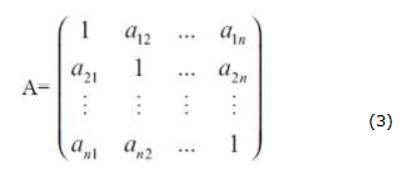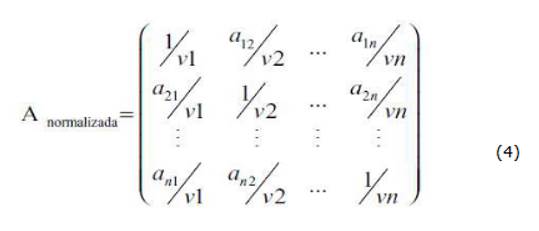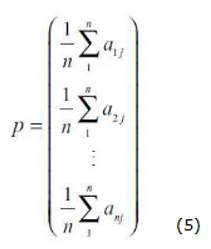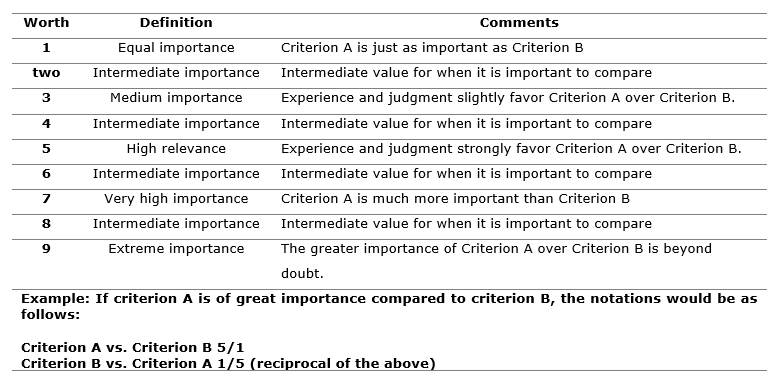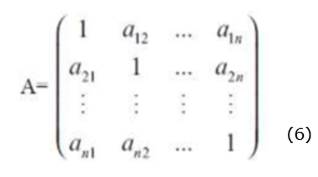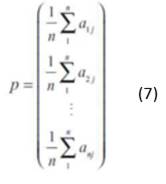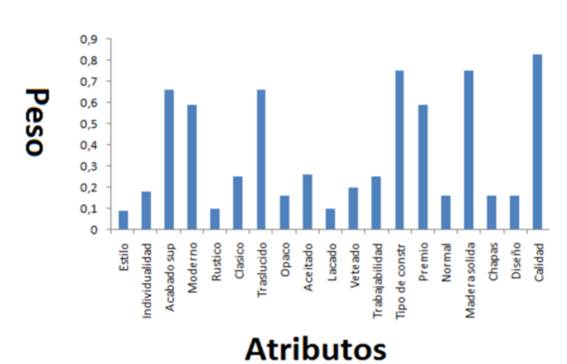Meu SciELO
Serviços Personalizados
Journal
Artigo
Indicadores
-
 Citado por SciELO
Citado por SciELO
Links relacionados
-
 Similares em
SciELO
Similares em
SciELO
Compartilhar
Revista Cubana de Ciencias Forestales
versão On-line ISSN 2310-3469
Rev cubana ciencias forestales vol.10 no.2 Pinar del Río maio.-ago. 2022 Epub 07-Ago-2022
Original article
Analysis of wood preferences for furniture production in Pinar del Río and Artemisa, Cuba
1Ministerio del Turismo, Pinar del Río, Cuba.
2Universidad de Pinar del Río "Hermanos Saíz Montes de Oca". Pinar del Río, Cuba.
The objective of this study was to determine the main preferred woods for the furniture manufacture in the provinces of Pinar del Rio and Artemisa. The method used to measure the preferences of the specialists was the so-called Hierarchical Analysis Process through the application of a survey to 350 individuals related to the consumption of wooden articles. The results obtained allowed us to define that the most preferred woods for the production of furniture are Swietenia mahagoni (L.) Jacq., Cedrela odorata L., Cordia gerascanthus (L.) Moldenke, Hibiscus elatus L. y Tectona grandis Sw. From the application of the hierarchical analysis of the species selection process, it is stated that the most accepted species is Swietenia mahagoni, presenting an acceptance range of 100 %. Respondents also state that the attributes associated with quality aspects have a great impact on the preference of the product over the designs, when the furniture is made of solid wood. Based on the forest management project of the Costa Sur (Artemisa), Pinar del Río and Macurije (Pinar del Rio) agroforestry companies, it was defined that Pinus caribaea var caribaea, Eucalyptus saligna, Samanea saman, Gmelina arborea y Acacia mangium have the potential to be used in the furniture industry based on their volumes and permanence in the forest heritage of the companies studied.
Keywords: Wood; Species; Processing; Quality; Existence.
INTRODUCTION
The global trend to use forest products or sub-products, especially those from natural forests, is motivating the introduction of species with high productive potential, hence the need to adapt the forestry industry to meet this growing demand (Valdés et al., 2019).
On the other hand, the great variability between forest species must also be considered, as well as their different technological properties. Among them, those that indicate possibilities of using wood for the most diverse purposes, counting among them, the furniture manufacture and the levels of customer satisfaction based on the well-being provided by wood (Lipovac and Burnard 2021).
It is significant to state that color is one of the most important characteristics for the identification, classification and suggestions of wood usage, mainly when it is associated with aspects related to its texture and design in final uses with greater added value (Valverde et al., 2020), mostly in the decoration, joinery and furniture industry.
In Cuba, although there are important technological advances in the sector, the level of knowledge in the area of workability properties of wood still needs to be improved (Valdés et al., 2018) . Therefore, despite the existence of high volumes of wood in the forest heritage of provinces like Pinar del Rio and Artemisa, little is known about their workability properties, which makes them species of little use in the wooden furniture industry.
The objective of this study is to determine the main preferential woods for the furniture manufacture in the provinces of Pinar del Rio and Artemisa.
MATERIALS AND METHODS
Characterization of the study area
The Agroforestry Company "Costa Sur" is located to the west of the province of Artemisa, which is bordered to the north by the Atlantic Ocean, to the south by the Caribbean Sea, to the east by the province of Havana and to the west by the province of Pinar del Rio. The area, covered by forests with respect to the total assets of the company, is located mainly towards the coastal areas, so its spatial distribution is negative, of which 88 % are natural forests with high levels of degradation (SEF 2020).
The Agroforestry Company "Macurije" is located in the westernmost region of the Pinar del Rio province, covering parts of the territories of the Guane and Mantua municipalities. It limits to the north with the coastline from Baja to Garnacha coves; to the east with the municipality of San Juan y Martinez, belonging to the Pinar del Rio Agroforestry Company; to the south with the municipality Sandino Empresa Agroforestal Guanacahabibes (EAF) and to the southeast with the coast of the Gulf of Mexico. Pinar del Rio Agroforestry Company is located in the central and southern part of the province of the same name, which includes the municipalities of San Juan y Martínez, San Luis, Pinar del Rio and Consolacion del Sur, bordered to the north by the municipalities Minas de Matahambres and Viñales, to the south with the Caribbean Sea, to the east with the municipality of Los Palacios and to the west with the municipality of Guane (Valdes et al., 2019).
Determination of sample size and sampling intensity
To determine the size of the sample (people to be surveyed), the survey method was applied through the questionnaire technique, personnel related to the consumption of wooden items (Anguita et al. 2003). The individuals were contacted in specialized stores, tourist facilities, sawmills, carpentry, construction works. Even professors of the Forest Engineering career at the University of Pinar del Rio were interviewed. The respondents represent a universe of 350 individuals.
The variable used was: years of experience of the respondents related to the processing and marketing of wood, which gave the possibility of developing stratified sampling which will provide an increase in the precision of population estimates (Cochran 1963).
To determine the number of people to survey, the population was stratified based on 5 years of experience or more, so three strata were formed:
Stratum 1 - 5 to 9 years of experience with a total of 112 individuals;
Stratum 2 - 10 to 14 years of experience with 186 individuals; and
Stratum 3 - with more than 14 years of experience with 52 individuals.
To determine the sampling intensity (sample size) of the stratified population, the following expression from Pellico and Brena (1997) was used for finite populations (Equation 1):
Where: n- total number of units sampled; h-size of the stratum t- percentile t for a given confidence (1-a) 100 %: E- margin of error willing to accept; N- potential total number of population units; L- number of strata; W h - proportion of the stratum in the total sample; stratum size; - variance of the strata
To determine the n-size of the sample in each stratum, the proportional distribution is used, meaning (Equation 2):
Where: n h number of units sampled per stratum; W h proportion of the stratum in the population; n total number of sampled units in the population.
Analysis of wood preferences by the consumer through the Hierarchy Analysis Process (AHP)
The method used to measure the preferences of the specialists was the so-called Analysis Hierarchy Process (AHP), proposed by Saaty (1980), used by Scholz and Decker (2007), as well as Beltran et al. (2021), with the intention to analyze this decision problem through the hierarchical structure, based on the individual decision of the elements.
In this case, the AHP intends to evaluate the tendencies that certain segments of the population have in relation to their preferences for wood for making furniture, taking into account the different attributes that characterize wood and its effect on the psychological well-being that this important raw material provides.
For the hierarchy of the model, the problem must be broken down into its relevant components. When building this model, enough details should be included to describe the problem as thorough as possible.
The maximum limit of the hierarchy represents the objective of the decision problem (Species preference in the elaboration of furniture). This objective was characterized from a first level of attributes (Criteria), within which Design and Quality were set. They were subdivided into several levels of attributes (Subcriteria), such as style, individuality, surface finish, work complexity, type of construction, modern rustic, classic, surface finish, translucent, opaque, skill in prize, normal, type of construction, solid, veneers, translucent oiled, lacquered and grained and finally the alternatives; which will be the species that are identified as the favorite ones; in correspondence with the methodology proposed by Roche and Vejo (2005).
According to Beltrán et al. (2021), in the next stage the possibilities of the alternatives (the 5 species selected as the most preferred) are evaluated through binary comparisons (pairwise) for each of the criteria and subcriteria established, the decision maker expresses his preference by assigning a numerical value to each comparison. At each level of the hierarchy, comparisons were made between pairs of elements of that level, based on the importance or contribution of each one of them to the higher-level element to which they are linked.
This comparison process will lead to a scale of relative measurement of priorities or weights of said elements. In both cases, the pairwise comparisons were made by means of preference ratios that were evaluated according to a numerical scale from 1 to 9.
Taking into consideration the work carried out by Berumen and Llamazares (2007), based on the results obtained, the following matrix was formed (Equation 3):
Once these matrices were constructed, they were normalized, dividing each number in the column by the total sum of the column and thus the normalized matrix was obtained (Equation 4)
Subsequently, an arithmetic average was calculated for each line of the normalized matrix and the Priority Vector for the alternatives, criteria and subcriteria was obtained (Equation 5).
In this case, the AHP tried to evaluate the tendencies that certain segments of the population have in relation to their preferences for wood for making furniture, taking into account the different attributes that characterize it. Therefore, data from pair comparisons were collected at the individual level through questionnaires applied to a group of 25 specialists who were chosen based on the predetermined objective and according to the criteria set forth by Barba and Pomerol (1997). In these cases, a geometric average of all the opinions issued by the specialists was obtained, coinciding with Roche and Vejo (2005).
The maximum limit of the hierarchy represents the objective of the decision problem (preference of species in the furniture manufacture). This objective was characterized from a first level of attributes (Criteria), within which the following were set:
Design and Quality. They were subdivided into several levels of attributes (Subcriteria), among which are: style, individuality, surface finish, work complexity, type of construction, modern rustic, classic, surface finish, translucent, opaque, skill in prize, normal, type of construction, solid, veneers, translucent oiled, lacquered and grained and finally the alternatives; which will be the species that are identified as the preferred ones; in correspondence with the methodology proposed by Roche and Vejo (2005).
In the next stage, the possibilities of the alternatives (the 5 species selected as the most preferred) were evaluated through binary comparisons (pairwise) for each of the established criteria and subcriteria, the decision maker expresses his preference by assigning a value numerical to each comparison.
At each level of the hierarchy, comparisons were made between elements of that level, based on the importance or contribution of each of them to the higher level element to which they are linked (Beltrán et al., 2021).
This comparison process leads to a scale of relative measurement of priorities or weights of those elements. In both cases, the pairwise comparisons are made by means of preference ratios that are evaluated according to a numerical scale from 1 to 9 proposed in Table 1.
With these results, the following matrix is formed: (Equation 6), according to Berumen and Llamazares (2007) (Equation 6):
Subsequently, an arithmetic average is made for each line of the normalized matrix and the Priority Vector is obtained for the alternatives, criteria and subcriteria (Equation 7)
Analysis of the consistency of the opinions expressed
Bearing in mind that respondents can make poor judgments when comparing some of the elements, an analysis of the consistency of the results obtained was carried out. For each line of the pair comparison matrix, a weighted sum is determined based on the sum of the product of each value of the same by the priority of the corresponding alternative (which arises from the priority vector). By averaging the results obtained, a λ maxBerumen et al., 2007) (Equation 8) was obtained:
Once it is obtained, the Consistency Index (Equation 9) is calculated (Moreira and Ortega (2021):
With this index, a measure of consistency was already obtained. But it should not be used because according to the AHP a certain value of this index is tolerable in an array of a certain dimension, but it is not tolerable in another of a different dimension. Because of this, Saaty (1980) developed a random consistency measure, uniform for all matrices (Table 2).
For these purposes, the Consistency Ratio was determined from the following equation (Moreira and Ortega 2021):
Where: RC- consistency ratio; IC consistency index; ICA- Random consistency index.
From the point of view of the AHP, it is desirable that the consistency ratio of any pairwise comparison matrix be less than or equal to 0.10 (Moreira and Ortega 2021.
Finally, the contribution of each element to the elements of the immediately higher level of the hierarchy was evaluated and the global contribution of each alternative to the main objective or goal was calculated. Excel was used as a tool to facilitate data processing. In the case of selecting the species preferred by wood consumers, a priority vector is defined for each sub-criterion and criterion, as well as for all the alternatives evaluated.
Analysis of the stock volumes of the preferred species in the furniture market and substitution alternatives
Finally, an analysis is made of the stock volumes in the forest estates of the species preferred by the respondents and the timber species with the greatest existence in the forest estates with the aim of proposing them as alternatives in the furniture sector in Pinar del Rio and Artemisa.
RESULTS AND DISCUSSION
Determination of the woods preferred by consumers
As a result of the applied survey, it was obtained that the five favorite species by consumers for the manufacture of furniture are Swietenia mahagoni (100 %), Cedrela odorata (98 %), Cordia gerascanthus (66.8 %), Hibiscus elatus (51.2 %) and Tectona grandis (39.2 %).
These results coincide with those of Valdés et al. (2014), where the perceptions of wood consumers identified the same species as the most preferred, resulting in Swietenia mahagoni the most precious of them.
When carrying out an analysis of the main criteria exposed by consumers referring to: quality of the wood, possibility for new designs, difficulty for being worked and characteristics of its surface finish, the respondents state that the wood used for the production of furniture has to be analyzed in its entirety because there are many factors that affect a correct selection, these approaches coinciding with the criteria issued by Laina et al. (2017), who point out that wood has a strong impact on customer preferences when it is analyzed the product as a whole.
The magnitude of the irregularities that are formed in the woodworking process depends on several interrelated factors, as well as the anatomical structure and physical properties of the wood. These elements must be taken into account when selecting the wood to use for making furniture.
There are several factors that influence the process of secondary transformation of wood and that participate in the formation of surfaces and in their final quality, among them are mainly the orientation of the grain, the moisture content, and the density of the wood; corroborating the approaches of Hazir and Koc (2018), in relation to the quality of wood and its derivatives.
Another of the results obtained from the surveys carried out in the research phase regarding the work complexity, refers that the quality of the surface finish depends to a great extent on the little knowledge of the industrialists, of the most suitable combinations for the processing of the wood; coinciding with the approaches of Singer and Ozçahin (2020).
When the number of blades and the speed of rotation of the head increase, a better surface finish is obtained (without quantifying the increase) in the piece, which coincides with Valdés et al. (2019), when establishing that the surface roughness is affected by different variables, for example, in woodworking and rotational speed, where an increase in rotational speed produces less rough surfaces.
Respondents also state that the attributes associated with quality aspects have a great impact on the preference of the product over the designs, when the furniture is made of solid wood, in this way the carpenters prefer Swietenia mahagoni, both in the classic product lines and in the country-style ones, which still have a stable market in the areas under study.
Use of Hierarchical Analysis in the process of selecting the preferred species based on the attributes of the wood
From the materialization of the proposed methodology, results were obtained related to the normalized matrix that defines the importance of each of the species in consumer preferences (Table 3).
From the results obtained, an arithmetic average was determined for each line of the normalized matrix and the priority vector for the alternatives, criteria and subcriteria was obtained (Figure 1).
In the case of selecting the species preferred by wood consumers, a priority vector is defined for each sub-criterion and criterion, as well as for all the alternatives evaluated. The final result of the hierarchical analysis of the species selection process shows that the species with the highest acceptance globally is mahogany, presenting an acceptance range of 54 %, as shown below:
Swietenia mahagoni = 0.52 *0.83+0.50*0.16+0.39*0.14 = 0.54*100 = 54 %.
Cedrela odorata = (0.23*0.83) + (0.16*0.16) + (0.25*0.14) = 0.245*100 = 24 %.
hibiscus elatus = (0.10*0.83) + (0.10*0.16) + (0.17*0.14) = 0.12 * 100 = 12 %.
Tectona grandis = (0.06*0.83) + (0.056*0.16) + (0.11*0.14) = 0.06*100 = 6 %.
Cordia gerascanthus = (0.03*0.83) + (0.056*0.16) + (0.07*0.14) = 0.04*100 = 4 %.
Availability of the five species preferred by the furniture industry
An analysis of the volumetric and surface existence of the four species preferred by wood consumers in the management projects of the Macurije, Pinar del Rio and ''Costa Sur'' Agroforestry Companies is shown in Table 4.
Table 4. - Availability of preferred timber species by the furniture sector
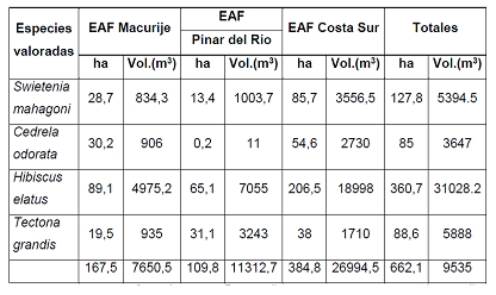
Source: State Forest Service (SEF)-Ministry of Agriculture (2020).
Cordia gerascanthus is not included in this table because at present it is in a state of sapling given the overexploitation, so no volumes of wood are reported by any of the three companies under study.
As can be seen from the table, the largest existence in surface and volume for the four species belong to the AFC Costa Sur followed by the AFC Macurije and the AFC Pinar del Rio, where the species in descending order that occupy the largest surface area and the largest volume of existence are Hibiscus elatus followed by Tectona grandis, Swietenia mahagoni and finally Cedrela odorata.
These results correspond to the areas of plantations prioritized by the companies due to the rapid growth for the cases of Hibiscus elatus and Tectona grandis and the vulnerability of Swietenia mahagoni and Cedrela odorata for Hypsipilla grandella's attackand for the use of Cedrela odorata to a greater extent for the manufacture of tobacco boxes, being a priority in the Pinar de Rio province (SEF 2020), which requires intensive management for both species.
Abundant species, but little used by the furniture industry
Other species that have ample existence in plantations and in volumes of wood within the forest heritage of the Macurije, Pinar del Rio and Costa Sur companies are shown in Table 5.
Table 5 - Availability of abundant species, but little preferred by the furniture sector
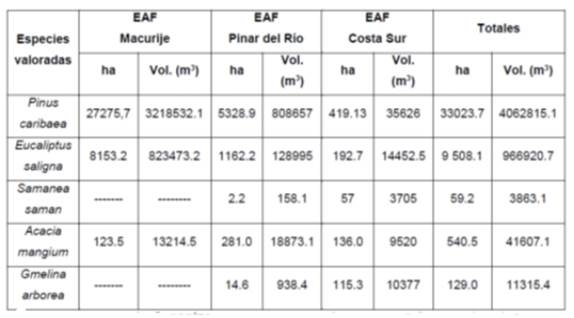
Source: State Forest Service (SEF)-Ministry of Agriculture (2020).
The species with the largest volume and area planted in the companies studied is the Pinus caribaea var. caribaea followed by Eucalyptus saligna, Gmelina arborea, Acacia mangium and Samanea saman in that order. The first two are prioritized in reforestation plans due to their uses and rapid growth, and the last two are one of recent introduction (Acacia mangium and Samanea saman) existing only in natural forests.
Comparing the results presented in Tables 4 and 5, in terms of surface area of the cited species, it can be seen that the Pinus caribaea var. caribaea, Eucalyptus saligna, Acacia magnium, Gmelina arborea and Samanea saman (all of relatively low preference in the furniture industry), are the species with the largest volume of existence, resulting, on the other hand, that the ones with the smallest amount in the area under study are Swietenia mahagoni, Cedrela odorata and Tectona grandis, which are together with Hibiscus elatus those preferred by consumers.
It is noteworthy that in the case of Hibiscus elatus despite being one of the preferred species, and therefore overexploited for furniture manufacturing, its abundance is currently relatively high, even higher than Samanea saman.
In the Forest Economy Organization and Development Projects of the three companies there are coincidences in that the volumes of wood of high-demand species are detrimental. That coincides with Valdés et al. (2014), who attributes that the existence of precious wood species is affected by the high existing demand, which causes an imbalance in the development classes of these species and their use. Hence, there are few usable individuals and in the case of Swietenia mahagoni and Cedrela odorata a low recruitment in the natural forest, which provokes a decrease in surfaces.
That is why, from the analysis of the high volumes of little-known wood species in the furniture industry, its use is recommended because reduces the current impact made on the wood species preferred by consumers.
It is also significant to define that the woods with the greatest existence in the production systems and the forest heritage that support them, are mostly characterized by presenting light tones that exert a marked influence on the psyche and the psychological well-being of the consumer. Which defines that color is one of the preferred factors when selecting a product derived from wood (Bello et al., 2020).
CONCLUSIONS
The most preferred species for furniture production in Pinar del Rio and Artemisa are Swietenia mahagoni, Cedrela odorata, Cordia gerascanthus, Hibiscus elatus and Tectona grandis.
The most widely accepted species globally is Swietenia mahagoni presenting an acceptance range of 54 %, as shown below.
The attributes associated with quality aspects have a great impact on the preference of the product over the designs, when the furniture is made of solid wood, Pinus caribaea var. caribaea, Eucalyptus saligna, Samanea saman, Gmelina arborea and Acacia mangium have the potential to be used in the furniture industry, taking into consideration their respective volumes and permanence in the forest heritage of the companies studied.
REFERENCIAS BIBLIOGRÁFICAS
ANGUITA, C., REPULLO, J. R., DONADO, J., 2003. La encuesta como técnica de investigación. Elaboración de cuestionarios y tratamientos estadísticos de los datos. Revista Aten Primaria, v. 31, n. 8, p. 527-538. Recuperado de: https://www.elsevier.es/es-revista-atencion-primaria-27 -articulo-la-encuesta-como-tecnica-investigacion?13047738 [ Links ]
BARBA, S., y POMERO, J. C., 1997. Decisiones multicriterio: Fundamentos teóricos y utilización práctica. Editora Universidad de Alcalá. Colección Economía. Madrid. España https://dialnet.unirioja.es/servlet/libro?codigo=372749 [ Links ]
BELLO, R., VARGAS, L., VALVERDE, J. C., CAMACHO, D y SALAS, C., 2020. Evaluación de la calidad de la madera utilizada en viviendas de interés social en Costa Rica. Revista Cubana de Ciencias Forestales, v. 8, n. 1, enero-abril. Recuperado de: http://scielo.sld.cu/scielo.php?script=sci_arttext&pid=S2310-34692020000100016 [ Links ]
BERUMEN, S. A., y LLAMAZARES, F., 2007. La utilidad de los métodos de decisión multicriterio (como el ahp) en un entorno de competitividad creciente Cuadernos de Administración, vol. 20, núm. 34, julio-diciembre, 2007, pp. 65-87. Recuperado de: http://www.redalyc.org/articulo.oa?id=20503404 [ Links ]
BELTRÁN, J. M., ACURIO, G. F., y ALULEMA, P. S. 2021. Método AHP de Saaty para determinar los factores del quantum indemnizatorio por daño inmaterial en materia penal en Ecuador. Revista Universidad y Sociedad, v. 13, n. 2, p. 249-256. http://scielo.sld.cu/scielo.php?script=sci_arttext&pid=S2218-36202021000200249 [ Links ]
COCHRAN, W. G., 1963. Sampling Techniques, 2nd Ed., New York. John Wiley and Sons, 413p. https://books.google.com.cu/books/about/Sampling_Techniques.html?id=8Y4QAQAAIAAJ&redir_esc=y [ Links ]
HAZIR, E., y KOC, K. H., 2018. A modelling study to evaluate the quality of Wood Science. Madera. Ciencia y Tecnología, v. 20, n. 4, p. 691-702. https://www.researchgate.net/publication/325987970_A_modeling_study_to_evaluate_the_quality_of_wood_surface [ Links ]
LAINA, R., SANZ, A., VILLASANTE, A., LÓPEZ, P, ROJAS, J. A.M., ALPUENTE, J., MONTERO, R. S., y VIGNOTE, S., 2017. Effect of the anatomical structure, wood properties and machining conditions on surface roughness of wood. Maderas. Ciencia y tecnología, v. 19, n. 2, p. 203-212. https://www.scielo.cl/scielo.php?script=sci_arttext&pid=S0718-221X2017000200008 [ Links ]
LIPOVAC, D., y BURNARD, M. D., 2021. Effects of visual exposure to wood on human affective states, physiological arousal and cognitive performance: A systematic review of randomized trials. Indoor and Built Environment 2021, Vol 30. no. 8 pp.1021-1041. Recuperado: DOI: 10.1177/1420326X20927437 [ Links ]
MOREIRA, L. F., y ORTEGA, C. F., 2021. Análisis jerárquico aplicado a la determinación de la fragilidad ambiental de la subcuenca del Río Carrizal. Pol. Con. (Edición núm. 56), v. 6, n. 3, p. 15-39. https://dialnet.unirioja.es/servlet/articulo?codigo=7926882 [ Links ]
PELLICO, S., y BRENA, D. A., 1997. Inventario florestal., Eds. Curitiba-PR. JOUR. [ Links ]
ROCHE, H., y VEJO, C., 2005. Métodos cuantitativos aplicados a la administración. Análisis multicriterio para la toma de decisiones, 2005 [citado 16/11/2013]. Recuperado de: Recuperado de: http://www.ccee.edu.uy/ensenian/catmetad/material/MdA-Scoring-AHP.pdf [ Links ]
SAATY, T. L., 1980. The Analytic Hierarchy Process, New York: McGraw-Hill. https://books.google.com.cu/books/about/The_Analytic_Hierarchy_Process.html?id=Xxi7AAAAIAAJ&redir_esc=y [ Links ]
SCHOLZ, S. W., y DECKER, R., 2007. Measuring the impact of wood species on consumer preferences for wooden furniture by means of the Analytic Hierarchy Process. Forest Prod. J, v. 57, n. 3, p. 23-28. Recuperado de: https://www.researchgate.net/publication/279766807_Measuring_the_impact_of_wood_species_on_consumer_preferences_for_wooden_furniture_by_means_of_the_Analytic_Hierarchy_Process [ Links ]
SERVICIO ESTATAL FORESTAL (SEF). 2020. Anuario. Programa de desarrollo Forestal 2020-2030. Ministerio de la Agricultura. Pinar del Río, Cuba. [ Links ]
SINGER, H., y OZÇAHIN, S. A., 2020. A multiple criteria analysis of factors influencing surface roughness of wood-based materials in the planning process. Cerne, v. 26, n. 1, p. 58-65. https://www.scielo.br/j/cerne/a/mxBDrPn3LQdshpY7J75wvfJ/?lang=en [ Links ]
VALDÉS, R. H., ALVAREZ, D. A., RAMÍREZ, A., GONZÁLEZ, I y PEÑALVER, A. 2014. Análisis de la utilización de diferentes especies maderables en la elaboración de artículos de alta demanda en el mercado de EFI Sierra Cristal perteneciente a la provincia Santiago de Cuba. Revista Forestal Baracoa, v 33, p. 14-23. https://www.academia.edu/20139356/ANALISIS_DE_LA_UTILIZACION_DE_DIFERENTES_ESPECIES_MADERABLES_EN_LA_ELABORACION [ Links ]
VALDÉS, R. H., FERNÁNDEZ, R. R., PUPO, I., y ALVAREZ, D., 2018. Análisis de la calidad del cepillado de la madera de diferentes especies procedentes de Pinar del Río y Artemisa, Cuba. Revista Cubana en Ciencias Forestales, v. 6, n. 3, p. 272-283. https://cfores.upr.edu.cu/index.php/cfores/article/view/362 [ Links ]
VALDÉS, R., et al 2019. Análisis de la rugosidad superficial de diferentes maderas en las provincias de Pinar del Río y Artemisa, Cuba. Revista Cubana en Ciencias Forestales, enero-abril, v. 7, n. 1, p.1-16. https://cfores.upr.edu.cu/index.php/cfores/article/view/386 [ Links ]
VALVERDE, J. C., ARIAS, D., ARIAS, K., CASTILLO, M., MILLER, C., AGUILAR, H., y FLORES, D., 2020. Identificación de patrones de reflectancia espectral y colorimétricos en madera seca de Peltogyne purpurea Pittier. Revista Cubana de Ciencias Forestales . 2020; mayo-agosto, v. 8, n. 2, p. 262-281. Recuperado de: https://cfores.upr.edu.cu/index.php/cfores/article/view/589 [ Links ]
Received: April 20, 2022; Accepted: August 01, 2022











 texto em
texto em 




